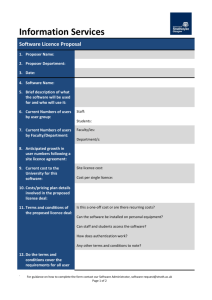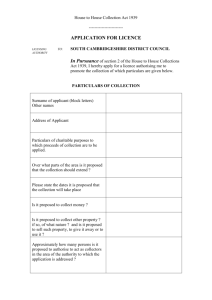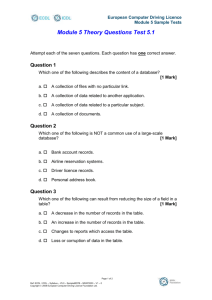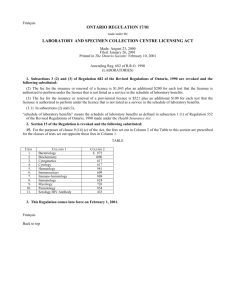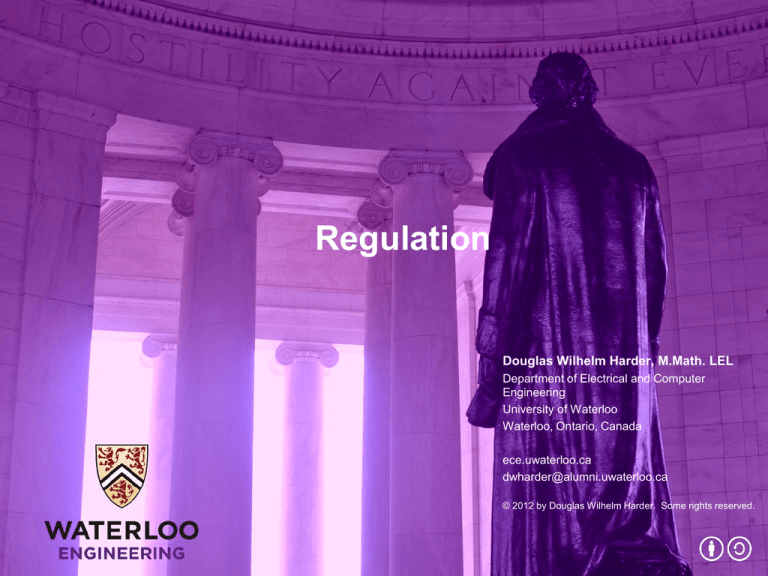
Regulation
Douglas Wilhelm Harder, M.Math. LEL
Department of Electrical and Computer
Engineering
University of Waterloo
Waterloo, Ontario, Canada
ece.uwaterloo.ca
dwharder@alumni.uwaterloo.ca
© 2012 by Douglas Wilhelm Harder. Some rights reserved.
Regulation
Outline
An introduction to the engineering profession, including:
– Standards and safety
– Law: Charter of Rights and Freedoms, contracts, torts, negligent
malpractice, forms of carrying on business
– Intellectual property (patents, trade marks, copyrights and
industrial designs)
– Professional practice
• Professional Engineers Act
• Professional misconduct and sexual harassment
– Alternative dispute resolution
– Labour Relations and Employment Law
– Environmental Law
2
Regulation
Self-Regulation
Regulate
To control, govern, or direct, especially by means of regulations or restrictions.
Regulation
A rule or principle governing behaviour or practice; especially such a directive
established and maintained by an authority.
Thus, a profession is a group of individuals who are controlled,
governed, or directed by the members of that group by means of
rules and principles that govern behaviour and practice of the
members
3
Regulation
Source of Authority
The government has the right to enact legislation to
govern the actions of citizens and those residing in
Canada and Ontario
The statute that governs the practice of professional
engineering is the Professional Engineers Act
– First enacted in 1922 with open membership—membership was
voluntary
– A number of structural failures led to the act being amended in
1937 requiring membership in the Association in order to be
eligible to engage in the practice of professional engineering
4
Regulation
Professional Engineers Act
The self-regulatory body set up by the act was the
Association of Professional Engineers, Ontario
– Now abbreviated as Professional Engineers Ontario, or PEO
The act defines:
–
–
–
–
–
–
–
The objectives of the association and its council
Meetings, membership, regulations, by-laws, and publications
The powers of the Attorney General
The framework for licensure and certification
The duties and powers of the various committees and councillors
The requirement for insurance
Details regarding discipline and enforcement
5
Regulation
Professional Engineers Act
6
Regulation
Professional Engineers Act
The legislative branch of parliament enacts statutes
– Only an act of parliament can compel the government to spend
money
The executive branch may enact regulations, codes,
orders-in-council, etc.
– PEO may make regulations through the approval of the
Lieutenant Governor with prior review by the Attorney General
– The Attorney General is a member of the Cabinet or Executive
Council of Ontario
– The Attorney General is the chief legal advisor to the
government with the responsibility for the oversight of the justice
system within the province
7
Regulation
Professional Engineers Act
The reason that this is a provincial act and not an act of
the federal Parliament of Canada is that the Constitution
of Canada prescribes
92. In each Province the Legislature may exclusively make Laws in
relation to Matters coming within the Classes of Subjects next
hereinafter enumerated; that is to say,
10. Local Works and Undertakings ...
16. Generally all Matters of a merely local or private
Nature in the Province.
The practice of professional engineering falls, at least,
under the first clause
8
Regulation
How Does PEO Regulate?
Section 7(1) of the Professional Engineers Act specifies
those items with respect to which PEO may make
regulations
–
–
–
–
The regulations are published under Ontario Regulation 941
There are 34 items listed in the act
There are 88 sections in O.Reg. 941
Each of the 88 sections must in some way regulate an aspect of
one of the 36 items
9
Regulation
How Does PEO Regulate?
For example, three items are:
19. respecting the advertising of the practice of professional
engineering;
20. prescribing a code of ethics;
21. defining professional misconduct for the purposes of this Act;
Three related sections of the regulations are:
75.
A Member or holder ... may advertise only...
77.
The following is the Code of Ethics of the Association...
72. (2) For the purposes of the Act and this Regulation,
“professional misconduct” means,
10
Regulation
How Does PEO Regulate?
PEO regulates the practice of professional engineering
through:
– The issuing of licences to those qualified to engage in the
practice of professional engineering
– The issuing of Certificates of Authorization for those
organizations wanting to engage in the business of providing
services that are within the practice of professional engineering
to the public
11
Regulation
Licences
Why does licensing improve the quality of engineering
services provided?
12
Regulation
Licences
Licence, n.
A formal, usually a printed or written permission from a
constituted authority to do something, e.g. to marry, to print or
publish a book, to preach, to carry on some trade, etc.; a permit.
License, v.
To grant (a person) a licence or authoritative permission to hold
a certain status or to do certain things, e.g. to practise some
trade or profession, to hold a curacy, to preach, to use armorial
bearings, to keep a dog, to carry a gun, etc.
Definitions from the Oxford English Dictionary: www.oed.com
cf. advice, n. and advise, v.
13
Regulation
Licences
Natural person, n.
A person having legal status as an individual human being, as
distinguished from a corporate body, representative, etc.
Legal person, n.
A natural person, corporate body, representative, etc. who has
full legal rights, being neither outlawed, excommunicated, nor in
any way disqualified from appearing in courts of law.
Definitions from the Oxford English Dictionary: www.oed.com
14
Regulation
Licences
PEO issues licences to natural persons who have
satisfied:
– The general requirements for licensure stated in the Professional
Engineers Act, and
– The specific requirements for licensure listed in the regulations
15
Regulation
From the Act
Issuance of licence
14. (1) The Registrar shall issue a licence to a natural person
who applies therefor in accordance with the regulations and,
(a)
(b)
(c)
(d)
(d.1)
(e)
Repealed: is a Canadian citizen;
is not less than eighteen years of age;
has complied with the academic requirements specified in
the regulations ..., including passing such examinations as
the Council sets or approves ..., or is exempted by the
Council from complying with the requirements;
has complied with the experience requirements specified in
the regulations for the issuance of the licence;
has complied with any other requirements specified in the
regulations for the issuance of the licence; and
is of good character.
16
Regulation
From the Regulations
33. (1) Each applicant for a licence shall comply with the
following rules:
1. The applicant shall demonstrate that he or she has obtained,
i. a bachelor’s degree in an engineering program from a
Canadian university that is accredited..., or
ii. equivalent engineering educational qualifications
2. 48 months of experience in the practice of professional
engineering that provides sufficient experience
3. Up to 12 months of the practical experience may be acquired
during co-operative education placements after 2B
4. At least 12 months of the balance referred to in paragraph 3 shall
be acquired in a Canadian jurisdiction
5. The applicant shall successfully complete the Professional
Practice Examination
17
Regulation
Restrictions on Practice
Is a civil engineer allowed to engage in the field of
electrical engineering?
– Konrad Zuse, who designed the first programmable electronic
computer—which happened to be Turing complete, was a civil
engineer
When you get your licence, you will note that there are
no restrictions
– Holders have a responsibility to not undertaking work they are
not competent to perform by virtue of their training and
experience
– Doing so is professional misconduct...
18
Regulation
Example
19
In or about mid-2002, the Splash Nightclub installed a wood sound barrier at the
south perimeter of a patio on its property located at 4170 South Service Road in
Burlington, Ontario. This barrier was required to be constructed as part of an
agreement between Splash Club and the Corporation of the City of Burlington.
The city expected the barrier to be constructed in accordance with industry
standards. The barrier was approximately 70' long, varying in height from 12' to 14',
and was reported to be framed with 8" × 8" posts, with 2" horizontal struts and 1"
vertical slats.
In June 2002, at the request of the owner of the Splash Club, Kwiatek undertook to
inspect the barrier to ensure its suitability for its intended purpose and to ensure its
compliance with relevant standards. At this time, Kwiatek did not hold a Certificate of
Authorization under the Act to offer and provide engineering services to the public.
In a sealed report dated June 18, 2002, which was submitted to the city, Kwiatek
indicated that he had inspected the barrier and found it to be “structurally adequate,
built in accordance with prevailing construction practice in Ontario.”
On July 9, 2002, a city by-law enforcement officer went, to the Splash Club and
observed, at that time, that sections of the sound barrier had failed and were lying on
the ground, apparently after being blown over by the wind.
Engineering Dimensions SEPTEMBER/OCTOBER 2004
Regulation
How Does PEO Regulate?
Members of PEO are those who have licences to
engage in the practice of professional engineering
– The majority of the Council of the Association are Members who
are elected by Members
– Members comprise the majority of all committees:
•
•
•
•
•
•
•
Executive Committee
Academic Requirements Committee
Experience Requirements Committee
Registration Committee
Complaints Committee
Discipline Committee
Fees Mediation Committee
Recall: the practice of professional engineering is self-regulating
20
Regulation
How Does PEO Discipline?
Another aspect is self-disciplining
– When members or holders of another licence or Certificate of
Authorization fails to maintain the minimum standards required—
that is, they are disciplined by PEO
– Members found guilty of professional misconduct or
incompetence can be prescribed penalties as allowed for in the
Professional Engineers Act under Section 28(4)
• More later...
21
Regulation
Other Licences
Is it reasonable to require that everyone who engages in
the practice of professional engineering acquire a
licence?
– What if a professional engineer from another jurisdiction needs
to be brought in for one specialized project?
– What if a professional engineer from another country has
immigrated to Ontario, has all the requisite experience with the
exception of the one-year experience in Canada?
– What if an individual has specialized knowledge but does not
have a complete engineering degree?
– What if a certified engineering technician would like to offer
engineering services as a technician to the public?
22
Regulation
Temporary Licences
43. The requirements and qualifications for the issuance of a
temporary licence are payment of the fee for the temporary licence
and one of the following:
1.
2.
3.
Residence in a province or territory of Canada other than Ontario and
membership in an association of professional engineers in another
province or territory of Canada that has objects similar to the objects of
the Association and that requires qualifications for membership at least
equal to the qualifications required for the issuance of a licence to
engage in the practice of professional engineering in Ontario.
Qualifications at least equal to the qualifications required for the
issuance of a licence to engage in the practice of professional
engineering in Ontario.
Wide recognition in the field of the practice of professional engineering
in respect of which the work to be undertaken under the temporary
licence relates and not less than ten years experience in such field.
23
Regulation
Temporary Licences
42. (1) Every temporary licence must specify,
(a) the works, facilities, machinery, equipment or other property in Ontario
to which the temporary licence relates;
(b) the name of the person, firm or corporation by whom the holder of the
temporary licence is employed or engaged to perform services in
Ontario within the practice of professional engineering;
(c) the name of the Member, if any, with whom collaboration is required
under this Regulation; and
(d) the period of time, not exceeding twelve months, for which the
temporary licence has been issued.
(2) It is a condition of every temporary licence that the services
within the practice of professional engineering that may be provided
by the holder of the temporary licence are limited to the services
specified in the temporary licence.
24
Regulation
Provisional Licences
44.1 (1) The Registrar may grant a provisional licence to an
applicant who complies with the requirements of paragraphs 1, 2, 3
and 5 of subsection 33 (1).
Paragraph 4 of subsection 33 (1) is
4. At least 12 months of the balance referred to in paragraph 3 shall be
acquired in a Canadian jurisdiction, under the supervision of one or
more persons legally authorized to engage in the practice of
professional engineering in that jurisdiction.
25
Regulation
Provisional Licences
44.1 (2) The following conditions apply to every provisional licence:
1.
2.
The provisional licence is valid for 12 months from the date of issue. It
may be renewed once for up to 12 months if the Registrar is of the
opinion that renewal is necessary to enable the applicant to acquire the
experience required by paragraph 4 of subsection 33 (1).
The holder of the provisional licence is entitled to practise professional
engineering only under the supervision of a professional engineer, and
shall not issue a final drawing, specification, plan, report or other
document unless the supervising professional engineer also signs and
dates it and affixes his or her seal to it.
26
Regulation
Limited Licences
46. The requirements and qualifications for the issuance of a limited
licence are:
1.
One or more of the following:
i.
A three-year diploma in engineering technology or a Bachelor of
Technology degree in engineering technology from an institution
approved by the Council.
ii. A four-year honours science degree in a discipline and from a
university approved by the Council.
iii. Academic qualifications accepted by the Council as equivalent to a
diploma or degree mentioned in subparagraph i or ii.
27
Regulation
Limited Licences
2.
3.
4.
5.
Thirteen years of experience in engineering work acceptable to the
Council, including the years spent in obtaining the post-secondary
academic training referred to in paragraph 1 with at least one year of
such experience under the supervision and direction of a Member or
Members or under the supervision of a person authorized to practice
professional engineering in the province or territory in Canada in which
the experience was acquired and at least the last two years of the
experience in the services within the practice of professional
engineering with respect to which the limited licence is to apply.
Payment of the fee prescribed by this Regulation for a limited licence.
Successful completion of the Professional Practice Examination.
Good character.
28
Regulation
Certified Engineering Technicians and Technologists
In technical fields associated with professions, should
technicians and technologists be allowed to practice
independently?
– Should dental hygienists be allowed to provide teeth-cleaning
services independent of being employed by a dentist?
– Should paralegals be allowed to provide legal services for lower
level courts and administrative tribunals?
– Should pharmacy technicians be allowed independent practice
under certain restrictions?
29
Regulation
Certified Engineering Technicians and Technologists
There is already a class of certified engineering
technicians and technologists who may practice
the application of engineering
12. (1) The work performed by a certified technician, a certified
engineering technician, applied science technologist or a certified
engineering technologist consists of providing technical services,
(a) within the framework of practices, codes and standards that are
established or enforced under an Act of Ontario or of Canada
(b) within the framework of published standards in the applicable
industry or field; and
(c) under the technical direction of a licensed member of an
appropriate profession ...
30
Regulation
Certified Engineering Technicians and Technologists
CETs, however, must be associated with the holder of a
Certificate of Authorization if they wish to offer services
to the public
The most recent changes to the Profession Engineers
Act allow for an engineering technologist class of limited
licence
– With a LET, an individual can acquire a Certificate of
Authorization and provide technical services to the public
31
Regulation
Certification
A licence identifies an individual as being qualified to
engage in the practice of professional engineering
– Such an individual can be hired through an employment contract
to provide professional engineering services to the employer
– Such contracts are subject to the Employment Standards Act
What happens if a legal person is not in a position to hire
a professional engineer, but requires:
– a design, advice, a reporting, or the directing or supervising of a
project that requires the application of engineering principles?
Recall, from the definition of a profession:
... prepared to exercise that skill in the interests of the public.
32
Regulation
Certification
For an engineer, the public is anyone other than the
engineer him or herself or the engineer’s employer
– Specific statutes are associated with employment:
• The Employment Standards Act, 2000
An engineer who is not employed to provide engineering
services directly to an employer but instead provides
services to the public is said to be in independent
practice
– Such an engineer is said to be retained by the client
33
Regulation
Employment versus
Independent Practice
Employment
34
Independent Practice
You work exclusively for one business entity
You are free to provide your services to more
than one business entity
Your employment contract addresses nondisclosure, ability to control work hours and
time off, expectations related to performance,
notice, termination and remuneration
Your relationships are independent contracts
or relationships, or business entities purchase
your time from an agency
Expenses are reimbursed
You invoice your expenses
You are paid a salary or wage
You are not paid if services are not performed
You are provided an office and equipment on
business premises
You acquire your own business facilities
You have set work hours
You are not restricted as to the hours of work
You are provided benefits, e.g., vacation pay
You receive no vacation pay or bonuses
Your work is covered under the business
entity’s professional liability insurance policy
You require your own professional liability
insurance
http://www.peo.on.ca/offering/CofA%20_Infoguide.pdf
Regulation
Certificate of Authorization
The concept of certifying the offering of professional
engineering services to the public is currently limited to
Ontario
– In other provinces, having a licence implies you may offer your
services to the public
The need for certification will become more clear once
we look at the requirements associated with certificates
of authorization
35
Regulation
Certificate of Authorization
From the act:
Issuance of certificate of authorization
15. (1) The Registrar shall issue a certificate of authorization to a
natural person, a partnership or a corporation that applies
therefor in accordance with the regulations if the requirements
and qualifications for the issuance of the certificate of
authorization set out in the regulations are met.
Supervision under certificate of authorization
17. (1) It is a condition of every certificate of authorization that the
holder of the certificate shall provide services that are within
the practice of professional engineering only under the
personal supervision and direction of a holder of a licence,
temporary licence or limited licence.
36
Regulation
Certificate of Authorization
From the regulations:
47. The requirements and qualifications for the issuance of a
certificate of authorization are:
1.
2.
The applicant must designate one or more holders of a licence,
temporary licence or limited licence, each of whom has at least
five years of professional engineering experience following the
conferral of a degree ... or the completion of an equivalent
engineering education.
The application for the certificate of authorization must state that
the persons named in paragraph 1 are,
i.
ii.
iii.
iv.
the applicant for the certificate of authorization,
employees of the applicant,
partners in the applicant, or
employees of partners in the applicant,
and will devote sufficient time to the work of the applicant to carry
out the responsibilities set out in paragraph 1.
37
Regulation
Certificate of Authorization
3.
The applicant must certify in a form that will be supplied by the
Registrar that,
i.
ii.
iii.
iv.
v.
the applicant is insured against professional liability in
accordance with subsection 74 (1),
the applicant is participating in the Indemnity Plan of the Ontario
Association of Architects in accordance with clause 74 (2) (a)
and the applicant’s practice is limited to professional activities
covered by that Plan,
the applicant has other insurance in accordance with clause
74 (2) (b),
the applicant is not required to have professional liability
insurance because any such insurance would be in respect of
pollution hazards, nuclear hazards, aviation hazards or shipping
hazards, or
the applicant will comply with section 74 in the manner provided
by that section by notifying each person to whom the applicant
intends to provide professional engineering services that the
applicant is not insured in accordance with the minimum
requirements of that section.
38
Regulation
Certificate of Authorization
Basically, this requires:
– Accountability
– Commitment
– Insurance
If a member of the public retains the holder of a
Certificate of Authorization to provide engineering
services, they need some surety
– As you may suspect, failure of professional engineers to, for
example, have professional liability insurance or lack of
accountability (“I thought he was working on that project...”) or
the engineers working on too many projects or perhaps on other
projects, led to the requirement to differentiate licensing from the
certification of providing services to the public...
39
Regulation
Restrictions
Licensing requirement
12. (1) No person shall engage in the practice of professional engineering or
hold himself, herself or itself out as engaging in the practice of professional
engineering unless the person is the holder of a licence, a temporary
licence, a provisional licence or a limited licence.
Certificate of authorization
(2) No person shall offer to the public or engage in the business of providing
to the public services that are within the practice of professional engineering
except under and in accordance with a certificate of authorization.
Offence, practice of professional engineering
40. (1) Every person who contravenes section 12 is guilty of an offence and
on conviction is liable for the first offence to a fine of not more than $25,000
and for each subsequent offence to a fine of not more than $50,000.
40
Regulation
The Engineer’s Seal
When a professional engineer provides a service to a
member of the public, the engineer applies his or her
seal onto the document
53. Every holder of a licence, temporary licence, provisional licence or
limited licence who provides to the public a service that is within
the practice of professional engineering shall sign, date and affix the
holder’s seal to every final drawing, specification, plan, report or other
document prepared or checked by the holder as part of the service
before it is issued.
41
Regulation
The Engineer’s Seal
The engineer’s seal is a sign of:
– Authorship:
– Responsibility:
– Reliance:
the signing engineer either authored or verified
the document
the engineer is taking responsibility for the
appropriateness of the document
the client, contractors, etc. for whom the
document has been prepared may rely on the
appropriateness for the purpose
42
Regulation
The Engineer’s Seal
When sealing documents:
– The original document must remain unsealed and it must be kept
by the engineer
– Only duplicates of final documents should be sealed and
disseminated
– If a preliminary or draft document must be sealed for registration
purposes, the document must clearly show that it is not to be
relied upon; e.g., the word “DRAFT” appearing both as a
watermark and in bold close to the seal
– Electronic documents should contain an
electronic copy of the seal and the electronic
document must be signed using a digital
signature
http://www.peo.on.ca/Guidelines/UseOfTheProfEngSeal2010.pdf
43
Regulation
Consulting Engineers
It is significantly more work to work in independent
practice than it is to work for an employer
– Independent practice requires significantly more varied skills and
organization and often such skills can only be honed with
practice
– How can a professional engineer identify him or herself as being
experienced in independent practice?
44
Regulation
Consulting Engineers
The Act makes provisions for the designation of
consulting engineer
56. (1) The Council shall designate as a consulting engineer every
applicant for the designation who,
(a) is a Member;
(b) is currently engaged, and has been continuously engaged, for not less than
two years or such lesser period as may be approved by the Council, in the
independent practice of professional engineering in Canada;
(c) has, since becoming a Member, had five or more years of professional
engineering experience that is satisfactory to the Council;
(d) has passed the examinations prescribed by the Council or has been
exempted therefrom, pursuant to subsection (2).
(2) The Council may exempt an applicant from any of the examinations
mentioned in clause (1) (d) where the Council is of the opinion that the
applicant has appropriate qualifications.
45
Regulation
Definitions
Throughout this course, these definitions will be used:
A Member is a professional engineer and member of the
Association of Professional Engineers Ontario (PEO)
A practitioner is any Member, any holder of either a Certificate of
Authorization or a temporary, provisional or limited licence
A holder of a licence is any Member or any holder a temporary,
provisional or limited licence
46
Regulation
Identification
It is important that the public can identify engineers
The Act prevents individuals from holding themselves out
as or identifying themselves as being professional
engineers or the holder of other licences
47
Regulation
Identification
Offence, use of term “professional engineer”, etc.
40. (2) Every person who is not a holder of a licence or a temporary licence
and who,
uses the title “professional engineer” or “ingénieur” or an abbreviation or
variation thereof as an occupational or business designation;
(a.1) uses the title “engineer” or an abbreviation of that title in a
manner that will lead to the belief that the person may
engage in the practice of professional engineering;
(b)
uses a term, title or description that will lead to the belief
that the person may engage in the practice of professional
engineering; or
(c)
uses a seal that will lead to the belief that the person is a
professional engineer,
(a)
is guilty of an offence and on conviction is liable for the first offence to a fine
of not more than $10,000 and for each subsequent offence to a fine of not
more than $25,000.
48
Regulation
Identification
Offence, services of professional engineer
40. (3) Every person who is not acting under and in accordance with a
certificate of authorization and who,
(a) uses a term, title or description that will lead to the belief that the person
may provide to the public services that are within the practice of
professional engineering; or
(b) uses a seal that will lead to the belief that the person may provide to the
public services that are within the practice of professional engineering,
is guilty of an offence and on conviction is liable for the first offence to a fine
of not more than $10,000 and for each subsequent offence to a fine of not
more than $25,000.
49
Regulation
Further Liabilities
Liability of directors and officers
40. (5) Where a corporation is guilty of an offence under subsection (1), (2),
(3) or (4), every director or officer of the corporation who authorizes, permits
or acquiesces in the offence is guilty of an offence and on conviction is
liable to a fine of not more than $50,000.
Liability of partners
40. (6) Where a person who is guilty of an offence under subsection (1),
(2), (3) or (4) is a member or an employee of a partnership, every member
of the partnership who authorizes, permits or acquiesces in the offence is
guilty of an offence and on conviction is liable to a fine of not more than
$50,000.
50
Regulation
References
[1]
Professional Engineers Act,
http://www.e-laws.gov.on.ca/html/statutes/english/elaws_statutes_90p28_e.htm
[2]
Ontario Regulation 941,
http://www.e-laws.gov.on.ca/html/regs/english/elaws_regs_900941_e.htm
[3]
[4]
Julie Vale, ECE 290 Course Notes, 2011.
Wikipedia, http://www.wikipedia.org/
These course slides are provided for the ECE 290 class. The material in it reflects
Douglas Harder’s best judgment in light of the information available to him at the
time of preparation. Any reliance on these course slides by any party for any other
purpose are the responsibility of such parties. Douglas W. Harder accepts no
responsibility for damages, if any, suffered by any party as a result of decisions
made or actions based on these course slides for any other purpose than that for
which it was intended.
51

